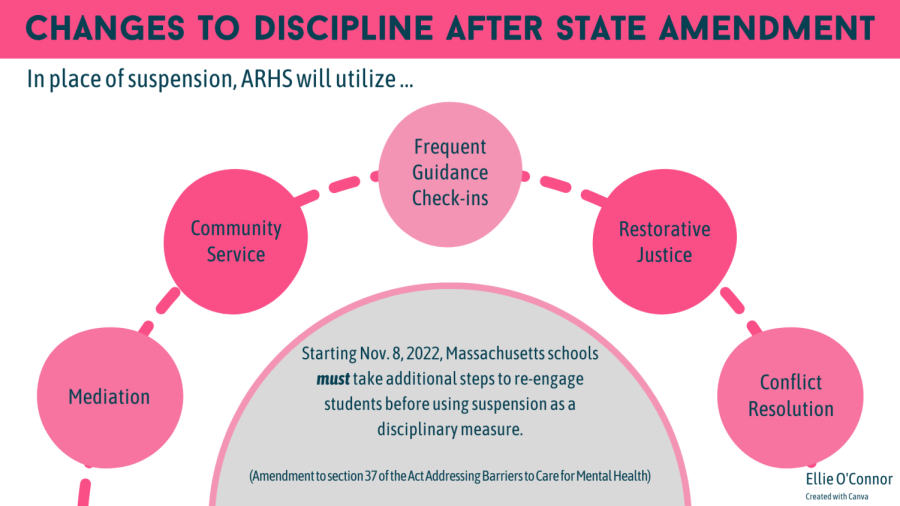Reevaluating discipline: New state-wide regulation prioritizes classroom time over suspensions
A new regulation that requires all Massachusetts public schools to take additional steps to re-engage students before using suspensions was put into place on Nov. 8, 2022.
February 1, 2023
A new regulation that requires all Massachusetts public schools to take additional steps to re-engage students before using suspensions was put into place on Nov. 8, 2022, in an effort to increase time in class and to support students through alternatives such as conflict resolution, community service and mediation.
The regulation is part of the larger Act Addressing Barriers to Care for Mental Health, which was developed at the state level. According to the Massachusetts Legislature, the change is due to an amendment to section 37 of the act, requiring schools to pursue alternative methods for discipline, rather than the previous recommendation to “consider” other options before a suspension. These alternatives can include community service projects or loss of social privileges as ways to develop long-term skills. This regulation does not extend to students facing felony or assault charges.
“One of the features of this act was for schools to be a little bit more flexible in dealing with student behavior issues,” Principal Sean Bevan said. “Specifically to require schools to be more innovative in how they respond to student disciplinary issues by reducing how much time students spend out of the classroom.”
Assistant Principal Janet Brown sees the policy change as a way for ARHS administration to support students, instead of relying on suspensions as a punishment.
“The administrative team already, philosophically, has that same belief system as the Commonwealth [of Massachusetts],” Brown said. “We are very careful and cautious about removing a student from the learning environment, and we’re getting better. A lot of students who are removed from the learning environment have other struggles, not just whatever the infraction was. So our job, fundamentally, is to support students in learning the behaviors that will help them develop into successful adults.”
While those in disciplinary situations may experience more complex plans to address behavior, Bevan hopes the changes go unnoticed by the majority of students and families due to discretion. Through alternative solutions such as community service, the changes described within the new regulation emphasize the importance of conflict resolution, mediation and collaboration.
“I think that a student would find in disciplinary situations that their administrators are working at the root cause of the infraction,” Brown said. “Also, teaching positive learning skills that students need to develop. They will see individualized programs developed for students who have significant infractions that ensure the safety of the community and the growth of the student.”
The new policy intends to increase equity in schools as well, a value that aligns with the ARHS administration’s goals.
“Not every student in the building has somebody to champion them, even in the midst of a misstep,” Brown said. “So what this law does is, and it’s something I believe very, very strongly in, is it helps us champion for that student. Struggling students need to be in school as much as possible, and sometimes, that’s the population that’s more likely to get suspended, since [suspensions] can unequally impact students of different socio-economic groupings.”
While the regulation requires schools to use alternative consequences for behavioral issues, suspensions are still a viable option when there are extenuating circumstances as to why a student is being disciplined.
“There are a lot of things that a student can do that we still have the ability to suspend,” Bevan said. “Anything related to health or safety or anything that would represent a significant disruption to the school environment, we have the ability to suspend for. And also, if we’ve already tried other avenues to redirect a student’s behavior, and those aren’t working, suspension is still an option.”
Additionally, the punishment for a discipline issue varies depending on the circumstances and those involved. Finding balance is key, according to Bevan.
“[Disciplining students is] all situation by situation,” Bevan said. “We don’t have any sentencing guidelines where we say if you do this one behavior, this is the exact consequences you get. But whenever there’s a double offense or there are some times where there’s a victim associated, a student who was the recipient of really poor behavior on another student’s behalf, we don’t want to be course-correcting so much that the victim in those situations doesn’t feel supported.”
Bevan sees the updated regulation as a turning point in how Massachusetts schools view discipline and the impacts it can have on students. As schools move away from suspensions, he hopes they can continue to help students develop.
“I think that increasingly, schools are looking at discipline as a process for students to grow, and less as a mechanism to achieve a penalty or justice for a student who’s done something unwise,” Bevan said. “I think it’s more in line with my personal view as an educator, that we’re here to teach students how to be functional and healthy adults that contribute to their community. So when a student does something to get themselves suspended, we really think of this consequence action as being, hopefully, a learning experience. Historically, schools have looked at [punishments] as a penalty, and there’s a subtle difference there, but it’s an important one.”










